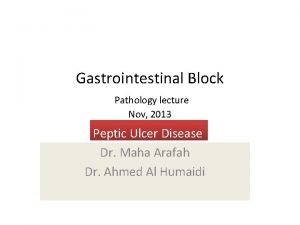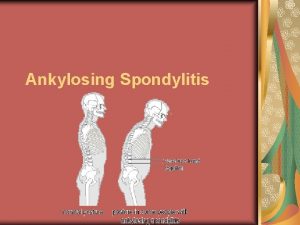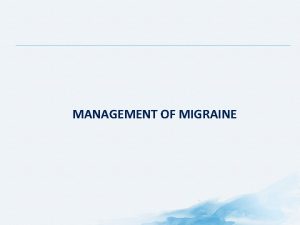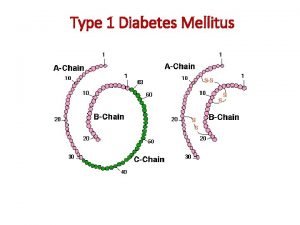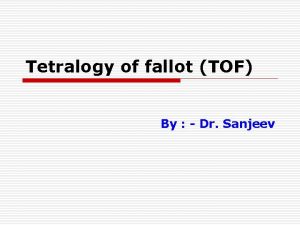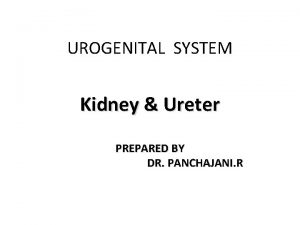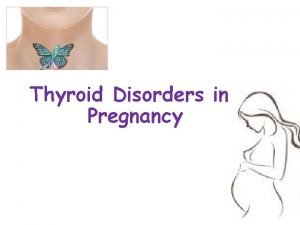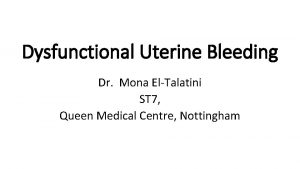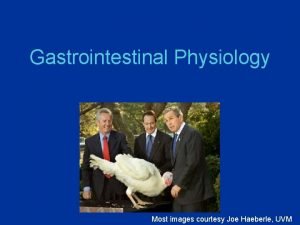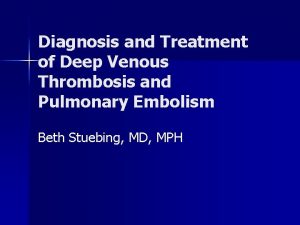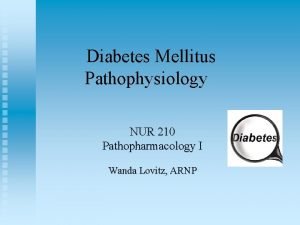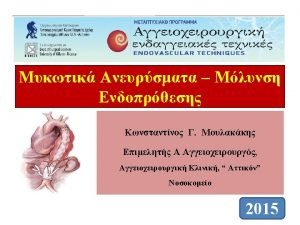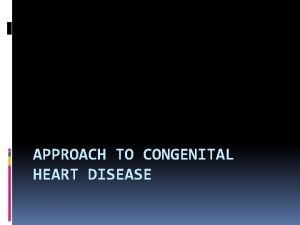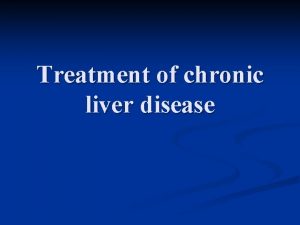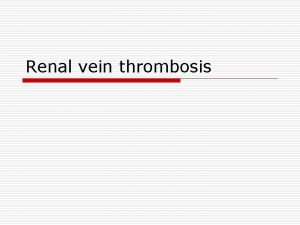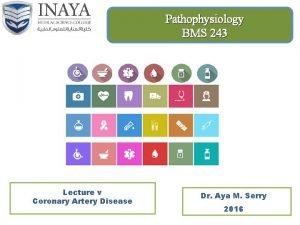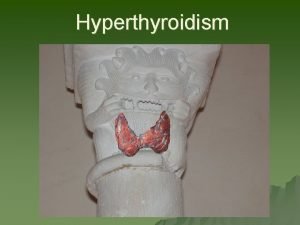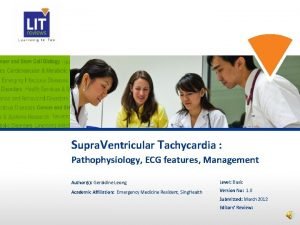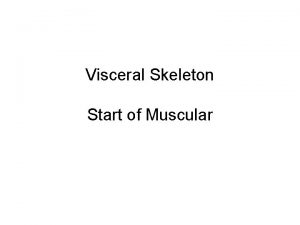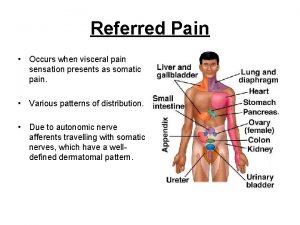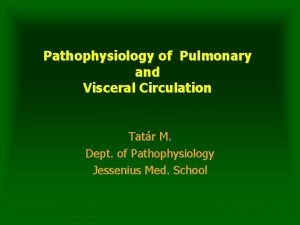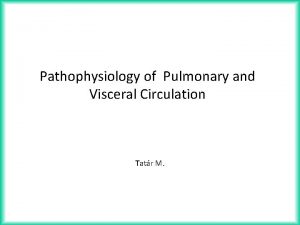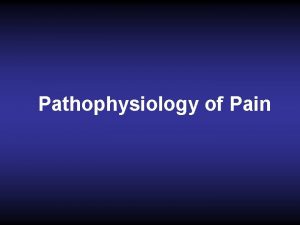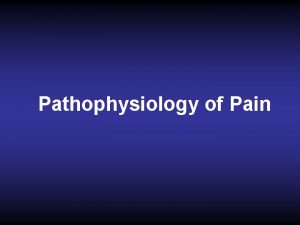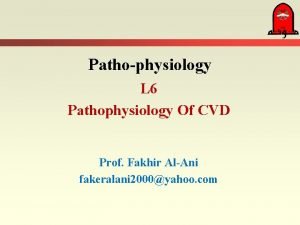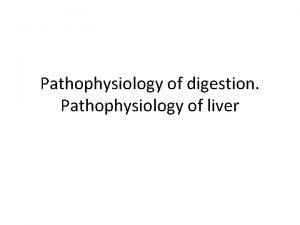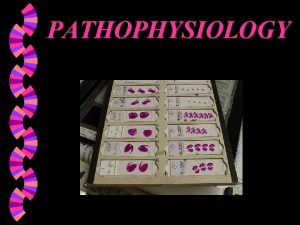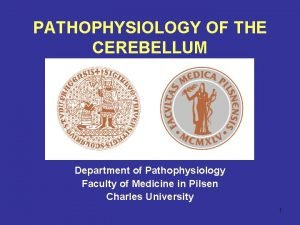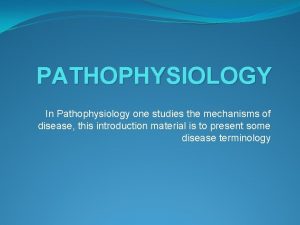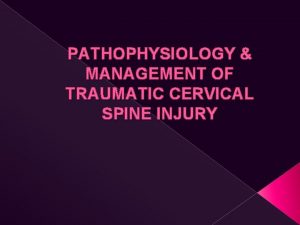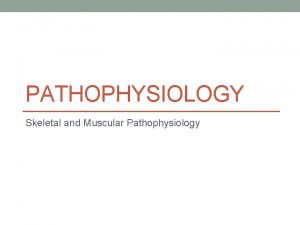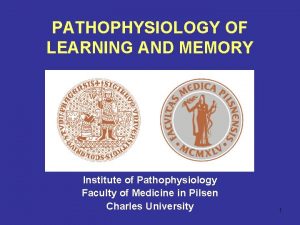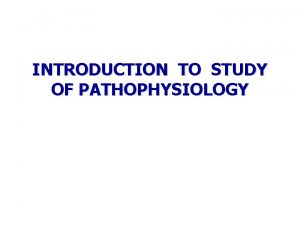Pathophysiology of Visceral Pain Etiologies of Visceral Pain






































- Slides: 38

Pathophysiology of Visceral Pain

Etiologies of Visceral Pain Source Examples Appendicitis Diverticulitis Colitis Gastric ulcer Inflammation • • Distention of a organ • Bowel obstruction • Block of bile duct by gallstones • Tumour invasion Swelling of liver capsule • Hepatitis • Tumors Ischemia • Ischemic colitis • Tumor invasion of blood supply • Mesenteric artery syndrome

Causes of Irritable Bowel Syndrome • Brain-gut signal problems • Gastrointestinal motor problems – hyper- or hypomotility • Hypersensitivity – lower pain threshold for bowel stretching • Mental health problems - anxiety, depression • Bacterial gastroenteritis • Small intestinal bacterial overgrowth (SIBO) • Body chemicals – neurotransmitters, hormones • Genetics • Food sensitivity – trigger foods It is believed that a combination of physical and mental health problems can lead to irritable bowel syndrome National Digestive Diseases Information Clearinghouse. Irritable Bowel Syndrome. Available at: http: //www. niddk. nih. gov/health-information/health-topics/digestivediseases/irritable-bowel-syndrome/Documents/ibs_508. pdf. Accessed March 24, 2015.

Causes of Interstitial Cystitis (IC) • Exact causes are unknown • Likely involves many factors • Patients with IC may also have a defect in bladder epithelium • Factors may include autoimmune reaction, genetics, infection, or allergy • May be a bladder manifestation of a more general inflammatory condition Some IC symptoms resemble those of bacterial infection but urine cultures indicate no infection Mayo Clinic. Interstitial Cystitis. Available at: http: //www. mayoclinic. org/diseases-conditions/interstitial-cystitis/basics/causes/con-20022439. Accessed March 24, 2015; National Kidney and Urologic Diseases Information Clearinghouse. Interstitial Cystitis/Painful Bladder Syndrome. Available at: http: //kidney. niddk. nih. gov/kudiseases/pubs/interstitialcystitis/IC_PBS_T_508. pdf. Accessed March 24, 2015.

Causes of Vulvodynia • Exact causes unknown • Possible contributors: – Injury to or irritation of nerves of vulvar region – Past vaginal infections – Allergies or sensitive skin – Hormonal changes • Some women with vulvodynia have a history of sexual abuse Most women with vulvodynia have no known causes Mayo Clinic. Vulvodynia. Available at: http: //www. mayoclinic. org/diseases-conditions/vulvodynia/basics/causes/con-20020326. Accessed March 24, 2015.

Causes of Endometriosis Retrograde menstruation Most likely cause Embryonic cell growth Surgical scar implantation Endometrial cells transport – transport of endometrial cells to other parts of the body • Immune system disorder – inability to recognize and destroy endometrial tissue growing outside uterus • • • Mayo Clinic. Interstitial Cystitis. Available at: : http: //www. mayoclinic. org/diseases-conditions/vulvodynia/basics/causes/con-20020326. Accessed March 24, 2015.

Causes of Acute and Chronic Pelvic Pain in Women Gynecological Causes • • • Pelvic inflammatory disease Ectopic pregnancy Adnexal torsion Ruptured ovarian cyst Adhesions Karnath BM, Breitkopf, DM. Hospital Physician. 2007; July: 41 -8. Other Causes • • • • Endometriosis Gynecologic malignancies Residual ovary syndrome Pelvic congestion syndrome Pelvic inflammatory disease Adhesions Leiomyomata Adenomyosis Ovulatory pain Adnexal cysts Cervical stenosis Chronic endometritis Intrauterine contraceptive device Uterine prolapse

Non-gynecologic Causes of Pelvic Pain Acute • • Diverticulitis Bowel obstruction Adhesions Hernia Urinary tract infection Urolithiasis Musculoskeletal Karnath BM, Breitkopf, DM. Hospital Physician. 2007; July: 41 -8. Chronic • • Diverticular disease Irritable bowel syndrome Inflammatory bowel disease Hernia Colorectal cancer Interstitial cystitis Musculoskeletal

Visceral Pain Conditions Inflammatory-related Conditions Pancreatitis Cholecystitis Diverticulitis Appendicitis Peritonitis Crohn’s Disease GERD Functional Visceral Pain Disorders IBS Non-ulcer dyspepsia Non-cardiac chest pain Neuropathic Visceral Pain Surgery/Trauma Birth GERD = gastro-esophageal reflux disease; IBS = irritable bowel syndrome Gynecological Pain Endometriosis Dysmenorrhea Interstitial cystitis (pelvic pain syndrome) Urological Pain Renal/urethral calculosis Post-operative Pain Major surgery Hypoperfusion/Ischemia Visceral Cancer Pain Ileus

Pain Classification Duration 1 Location 2 Severity 3 Acute Head Mild Nociceptive Low back Moderate Neuropathic Severe Central sensitization/ dysfunctional Chronic Etc. Pathophysiology 4, 5 1. Mc. Mahon SB, Koltzenburg M. In: Mc. Mahon SB, Koltzenburg M (eds). Wall and Melzack’s Textbook of Pain. 5 th ed. Elsevier; London, UK: 2006; 2. Loeser D et al (eds). Bonica’s Management of Pain. 3 rd ed. Lippincott Williams & Wilkins; Hagerstown, MD: 2001; 3. Hanley MA et al. J Pain 2006; 7(2): 129 -33; 4. Jensen TS et al. Pain 2011; 152(10): 2204 -5; 5. Woolf CJ. Pain 2011; 152(3 Suppl): S 2 -15.

Characteristics of Nociceptive Pain Type of pain Nociceptor location Superficial somatic pain • Skin • Subcutaneous tissue • Mucous membranes Deep somatic pain • • • Visceral pain Muscles Tendons Joints Fasciae Bones • Visceral organs* Potential stimuli • External mechanical, chemical or thermal events • Dermatologic disorders Pain localization Well localized Overuse strain Mechanical injury Cramping Ischemia Inflammation Localized or diffuse and radiating • Organ distension Muscle spasm • Traction • Ischemia • Inflammation Well or poorly localized • • • *Visceral organs include the heart, lungs, gastrointestinal tract, pancreas, liver, gallbladder, kidneys and bladder American Pain Society. Pain: Current Understanding of Assessment, Management, and Treatments. Available at: http: //www. npcnow. org/system/files/research/download/Pain-Current-Understanding-of-Assessment-Management-and-Treatments. pdf. Accessed March 24, 2015.

Examples of Nociceptive Pain Type of Pain Quality Signs and Symptoms Superficial somatic pain • Sharp, pricking or burning sensation • Cutaneous tenderness Hyperalgesia Hyperesthesia Allodynia Deep somatic pain • Usually dull or aching, cramping • Tenderness • Reflex muscle spasm • Sympathetic hyperactivity† Visceral pain* • • Deep aching or sharp • stabbing pain, which • is often referred to • cutaneous sites • • Malaise Nausea Vomiting Sweating Tenderness Reflex muscle spasm Examples • Sun, chemical or thermal burns • Skin cuts and contusions • Arthritis pain • Tendonitis • Myofascial pain • • • Colic Appendicitis Pancreatitis Peptic ulcer disease Bladder distension *Visceral organs include the heart, lungs, gastrointestinal tract, pancreas, liver, gallbladder, kidneys and bladder †Symptoms and signs of sympathetic (autonomic) nervous system hyperactivity include increased heart rate, blood pressure, and respiratory rate; sweating pallor; dilated pupils; nausea; vomiting dry mouth; and increased muscle tension American Pain Society. Pain: Current Understanding of Assessment, Management, and Treatments. Available at: http: //www. npcnow. org/system/files/research/download/Pain-Current-Understanding-of-Assessment-Management-and-Treatments. pdf. Accessed March 24, 2015.

Nociception To brain Dorsal root Neurons Dorsal root ganglion III II I Corticospinal tract Spinothalamic tract Aδ and C fibers Dubin AE, Patapoutian A. J Clin Invest 2010; 120(11): 3760 -72; Fields HL et al. Neurobiol Dis 1998; 5(4): 209 -27; Williams SJ, Purves D. Neuroscience. Sinauer Associates; Sunderland, MA: 2001. .

Sensitization and Visceral Pain • Visceral pain involves visceral hyperalgesia • Increased sensitivity has two causes 1. A change of sensory neurons in the viscera; they respond more intensely to naturally occurring stimuli and 2. An enhanced sensitivity of the sensory pathways in the brain that mediate sensations from the viscera • Both processes are known as “sensitization” • Peripheral sensitization occurs in the viscera • Central sensitization occurs in the brain Both types of sensitization are thought cause the pain produced by the inflammatory disease/injury and the hyperalgesia that occurs without an identifiable cause Cervero F. Available at: http: //www. wellcome. ac. uk/en/pain/microsite/science 3. html. Accessed 8 January, 2015.

Visceral Hyperalgesia in Irritable Bowel Syndrome Patients with IBS report pain at lower distension volumes of the colon than normal subjects IBS = irritable bowel syndrome Gebhart GF. Gut. 2000; 47: iv 54 -iv 55.

What is central sensitization/ dysfunctional pain? Definition Examples • Amplification of neural signaling within the CNS that elicits pain hypersensitivity • Fibromyalgia • Irritable bowel syndrome • Interstitial cystitis • Temporomandibular joint pain • May be present in many patients with chronic low back pain, osteoarthritis and rheumatoid arthritis CNS = central nervous system Woolf CJ. Pain 2011; 152(3 Suppl): S 2 -15. Pain Quality • Burning • Lancinating • Electric shock-like • Often diffuse • Frequently with allodynia and/or hyperalgesia

Central Sensitization Produces Abnormal Pain Signaling Brain Pain treatment options • α 2δ inhibitors Perceived pain (hyperalgesia/ allodynia) • Antidepressants Increased release of pain neurotransmitters glutamate and substance P Minimal stimuli Pain amplification Increased neuronal excitability Nociceptive afferent fiber Spinal cord Adapted from: Campbell JN, Meyer RA. Neuron 2006; 52(1): 77 -92; Gottschalk A, Smith DS. Am Fam Physician 2001; 63(10)1979 -86; Henriksson KG. J Rehabil Med 2003; 41(Suppl): 89 -94; Larson AA et al. Pain 2000; 87(2): 201 -11; Marchand S. Rheum Dis Clin North Am 2008; 34(2): 285 -309; Rao SG. Rheum Dis Clin North Am 2002; 28(2): 235 -59; Staud R. Arthritis Res Ther 2006; 8(3): 208 -14; Staud R, Rodriguez ME. Nat Clin Pract Rheumatol 2006; 2(2): 90 -8; Vaerøy H et al. Pain 1988; 32(1): 21 -6; Woolf CJ et al. Ann Intern Med 2004; 140(6): 441 -51.

Central Sensitization Ca 2+ channel Presynaptic Ca 2+ ion Believed to result from excessive release of Substance P and glutamate Neurotransmitters Postsynaptic Costigan M et al. Annu Rev Neurosci 2009; 32: 1 -32; Costigan M et al. In: Siegel GJ et al (eds). Basic Neurochemistry: Molecular, Cellular and Medical Aspects. 7 th ed. Elsevier Academic Press; Burlington, MA: 2006; Staud R. Arthritis Res Ther 2006; 8(3): 208 -14.

Central Sensitization C fiber terminal PGE 2 (+) GABA Glycine Glutamate P Substance P AMPA P Ca++ (+) Dorsal horn neuron NMDA (-) on Glycine receptors (+) Inhibitory Inter-neuron PGE 2 PKC (+) Na+ PGE 2 COX-2 induction AMPA = α-amino-3 -hydroxy-5 -methyl-4 -isoxazolepropionic acid; GABA = γ-aminobutyric acid; NMDA = N-methyl-D-aspartate; prostaglandin E; PKC = protein kinase C Woolf CJ, Salter MW. Science 2000; 288(5472): 1765 -9.

Peripheral Sensitization Primary afferent nerve fibers Dorsal horn neurons NGF NGF Neuropeptide release NGF Innocuous stimulus PAIN Ørstavik K et al. Brain 2003; 126(Pt 3): 567 -78; Woolf CJ, Mannion RJ. Lancet 1999; 353(9168): 1959 -64.

Pathway of Pain from Peripheral Receptors to Cortical Areas a = secondary somatosensory area b = limbic areas including the cingulate cortex c = spinal cord d = peripheral receptors Patrizi F et al. The Scientific World J. 2006; 6: 472 -90.

Pathophysiology of Visceral Pain • Correlated with excitation of spinal visceral afferents and (in general) not with the excitation of vagal afferents • Spinal visceral afferents are polymodal • Can be excited by physical and chemical stimuli • All groups of visceral afferents can be sensitized • Normally silent visceral afferents are recruited by inflammation • Individual visceral afferent neurons project in laminae I and V of the dorsal horn over several segments • Medio-lateral over entire width of dorsal horn and to contralateral side • Activity is synaptically transmitted to viscero-somatic convergent neurons, which receive additional afferent synaptic input from skin and deep somatic tissues of the corresponding dermatomes, myotomes, and sclerotomes Jänig W, Häbler HJ. Physiology and pathophysiology of visceral pain. Schmerz. 2002; 16(6): 429 -46.

Pathophysiology of Visceral Pain • Usually felt around midline because visceral organs are supplied with afferents bilaterally • Exceptions due to unilateral or predominantly unilateral innervation: • Cecum, ascending colon, descending colon, sigmoid colon, kidneys, ureters • Poorly localized and diffuse pain is due to low density of sensory innervation of viscera and extensive functional divergence of visceral input within CNS • Viscerovisceral convergence at central level contributes to relative difficulty in pinpointing the source of visceral pain CNS = central nervous system. Giamberardino MA, Vecchiet L. Curr Pain Headache Reports. 1997; 1: 23 -33.

Visceral Afferent Fibers and Visceral Pain • Sensory fibers in viscera are constituents of spinal and cranial nerves • Cell bodies are in posterior root ganglia of spinal nerves or ganglia of cranial nerves • Distal processes occur via sympathetic and parasympathetic nerves to reach viscera • Central processes pass via the dorsal (and sometimes the ventral) roots • Size range of fibers is comparable to that of cutaneous fibres • However, there is a considerably higher proportion of small fibers • A-δ predominates among A fibers • Ratio of A to C fibers differs in dorsal root and visceral nerves: • A: C in dorsal root = 1: 2 A: C in visceral nerves = 1: 8 or 1: 10 • Density of innervation of viscera by spinal afferents is low vs. density of afferent innervation in skin, deep somatic tissues • However, visceral afferent terminals are widely distributed in spinal cord A few visceral afferent fibers can activate many neurons in the spinal cord through extensive functional divergence Giamberardino MA, Vecchiet L. Curr Pain Headache Reports. 1997; 1: 23 -33.

Viscerosomatic Convergence • Most second-order neurons receiving visceral inputs are in laminae I and V of dorsal horn • Also located in the ventral horn of the spinal cord • Fewest neurons in the superficial dorsal horn • Limited ipsilateral input and a cutaneous output • Subjected to descending inhibitory control • Project to the brain via spinothalamic pathways • Most neurons are in the deep dorsal and ventral horn • Have a diffuse and bilateral visceral and somatic input • Subjected to descending excitatory and inhibitory control • No evidence for the existence of neurons that are exclusively concerned with visceral afferents • Therefore, viscerosomatic convergence is the norm Visceral sensations can be mediated only through convergent signals via somatosensory pathways Giamberardino MA, Vecchiet L. Curr Pain Headache Reports. 1997; 1: 23 -33.

Viscerosomatic Convergence and Referred Pain • Neurophysiological convergence of visceral and afferent inputs to CNS is thought to underlie referred pain • Noxious stimulation of viscera triggers pain referred to somatic sites • May be due to scarcity of visceral afferent fibers with spinal cord terminations • Relative contribution of visceral afferent fibers to total spinal cord afferent input is <10% • Visceral afferent terminals show extensive divergence and intraspinal distribution vs. cutaneous afferents CNS = central nervous system Sikandar S, Dickenson AH. Curr Opin Support Palliat Care. 2012; 6(1): 17 -26.

Viscerosomatic Convergence in the Central Nervous System Spinal Cord • Superficial dorsal horn (neurons with visceral and superficial somatic input) • Deep dorsal horn and ventral horn (neurons with visceral and deep somatic input) Supraspinal Centers • Brain stem • Thalamus • Cortex Visceral sensations can be mediated only through convergent signals via somatosensory pathways Giamberardino MA, Vecchiet L. Curr Pain Headache Reports. 1997; 1: 23 -33.

Viscerovisceral Convergence Both viscerosomatic and viscerovisceral convergence are maintained at the supraspinal level (e. g. , brain stem, thalamus, cerebral cortex) Giamberardino MA, Vecchiet L. Curr Pain Headache Reports. 1997; 1: 23 -33.

Brain-Gut Axis in Visceral Pain • Gut and brain communicate by multiple means • Alterations in secretion of corticotropin-releasing factor (CRF) and expression of its receptor implicated in pathology stress-related illnesses, anxiety, depression, changes in GI motility, changes in visceral sensation • CRF-receptor agonists can block increased colonic activity and painful sensations induced by acute or chronic stress • Gut sends information to brain via ascending fibers in vagus nerve • Central amygdala transforms noxious and stressful signals into behavioral and autonomic responses, including anxiety and depression • Electrical modulation of vagus nerve approved by FDA to treat depression The vagus nerve can modulate emotional responses to GI stimulation GI = gastrointestinal IASP. Painful functional bowel disorders: psychological factors. Available at: http: //www. iasppain. org/files/Content. Folders/Global. Year. Against. Pain 2/Visceral. Pain. Fact. Sheets/4 -Psychological. pdf. Accessed 13 January 2015.

Central and Peripheral Pathways of the Brain-Gut Axis Elsenbruch S. Brain Behav Immun. 2011; 25(3): 386 -94.

Brain-Gut Axis in Visceral Pain Cognitive, emotional, and autonomic centres in the brain Brain-gut axis Neuroendocrine centres, enteric nervous system, and immune system Altered brain-gut interactions can contribute to autonomic dysregulation of the gut and associated pain and perceptual changes in visceral disorders Sikandar S, Dickenson AH. Curr Opin Support Palliat Care. 2012; 6(1): 17 -26.

Bi-directionality of the Brain-Gut Pathway in FGIDs • Evidence indicates a brain-to-gut pathway may account for GI symptoms in some FGIDs • Other evidence indicates the gut may be the primary driver of symptoms • Via gut to brain connections, possibly via cytokines • It has been shown that both brain-gut and gut-brain pathways may occur in FGIDs • In IBS and FD, it appears the brain-gut pathway is dominant FGID = functional gastrointestinal disorder; GI = gastrointestinal; IBS = inflammatory bowel disease Koloski NA et al. Gut. 2012; 61(9): 1284 -90.

Literature cited American Pain Society. (n. d. -b). Pain: Current Understanding of Assessment, Management, and Treatments - Pain-Current-Understanding-of-Assessment-Management-and-Treatments. pdf. Retrieved June 24, 2015, from http: //www. npcnow. org/system/files/research/download/Pain. Current-Understanding-of-Assessment-Management-and-Treatments. pdf Campbell, J. N. , & Meyer, R. A. (2006). Mechanisms of neuropathic pain. Neuron, 52(1), 77– 92. http: //doi. org/10. 1016/j. neuron. 2006. 09. 021 Cervero, F. (n. d. ). Visceral pain. Retrieved June 24, 2015, from http: //www. wellcome. ac. uk/en/pain/microsite/science 3. html Elsenbruch, S. (2011). Abdominal pain in Irritable Bowel Syndrome: a review of putative psychological, neural and neuro-immune mechanisms. Brain, Behavior, and Immunity, 25(3), 386 – 394. http: //doi. org/10. 1016/j. bbi. 2010. 11. 010 Gebhart, G. F. (2000). Visceral pain-peripheral sensitisation. Gut, 47 Suppl 4, iv 54– 55; discussion iv 58. Gottschalk, A. , & Smith, D. S. (2001). New concepts in acute pain therapy: preemptive analgesia. American Family Physician, 63(10), 1979– 1984.

Literature cited Hanley, M. A. , Masedo, A. , Jensen, M. P. , Cardenas, D. , & Turner, J. A. (2006). Pain interference in persons with spinal cord injury: classification of mild, moderate, and severe pain. The Journal of Pain: Official Journal of the American Pain Society, 7(2), 129– 133. http: //doi. org/10. 1016/j. jpain. 2005. 09. 011 Henriksson, K. G. (2003). Fibromyalgia--from syndrome to disease. Overview of pathogenetic mechanisms. Journal of Rehabilitation Medicine, (41 Suppl), 89– 94. iasp-pain. org. (n. d. ). Painful Functional Bowel Disorders: Psychological Factors. Retrieved June 25, 2015, from http: //www. iasppain. org/files/Content. Folders/Global. Year. Against. Pain 2/Visceral. Pain. Fact. Sheets/4 Psychological. pdf Jänig, W. , & Häbler, H. J. (2002). [Physiology and pathophysiology of visceral pain]. Schmerz (Berlin, Germany), 16(6), 429– 446. http: //doi. org/10. 1007/s 00482 -002 -0187 -5 Jensen, T. S. , Baron, R. , Haanpää, M. , Kalso, E. , Loeser, J. D. , Rice, A. S. C. , & Treede, R. -D. (2011). A new definition of neuropathic pain. Pain, 152(10), 2204– 2205. http: //doi. org/10. 1016/j. pain. 2011. 06. 017 Koloski, N. A. , Jones, M. , Kalantar, J. , Weltman, M. , Zaguirre, J. , & Talley, N. J. (2012). The brain-gut pathway in functional gastrointestinal disorders is bidirectional: a 12 -year prospective population-based study. Gut, 61(9), 1284– 1290. http: //doi. org/10. 1136/gutjnl-2011 -300474

Literature cited Larson, A. A. , Giovengo, S. L. , Russell, I. J. , & Michalek, J. E. (2000). Changes in the concentrations of amino acids in the cerebrospinal fluid that correlate with pain in patients with fibromyalgia: implications for nitric oxide pathways. Pain, 87(2), 201– 211. Marchand, S. (2008). The physiology of pain mechanisms: from the periphery to the brain. Rheumatic Diseases Clinics of North America, 34(2), 285– 309. http: //doi. org/10. 1016/j. rdc. 2008. 04. 003 Mayo Clinic. (n. d. ). Interstitial cystitis Causes - Mayo Clinic. Retrieved June 24, 2015, from http: //www. mayoclinic. org/diseases-conditions/interstitial-cystitis/basics/causes/con-20022439 Mc. Mahon, S. B. (Ed. ). (2013). Wall and Melzack’s textbook of pain (6 th ed). Philadelphia, PA: Elsevier/Saunders. (2009). Bonica’s Management of Pain (Fourth edition). Baltimore, MD: LWW. National Institute of Diabetes and Digestive Kidney Diseases. (n. d. ). Irritable Bowel Syndrome. Retrieved June 24, 2015, from http: //www. niddk. nih. gov/health-information/healthtopics/digestive-diseases/irritable-bowel-syndrome/Documents/ibs_508. pdf Ørstavik, K. , Weidner, C. , Schmidt, R. , Schmelz, M. , Hilliges, M. , Jørum, E. , … Torebjörk, E. (2003). Pathological C-fibres in patients with a chronic painful condition. Brain: A Journal of Neurology, 126(Pt 3), 567– 578.

Literature cited Pain: Current Understanding of Assessment, Management, and Treatments - Pain-Current. Understanding-of-Assessment-Management-and-Treatments. pdf. (n. d. -b). Retrieved from http: //www. npcnow. org/system/files/research/download/Pain-Current-Understanding-of. Assessment-Management-and-Treatments. pdf Patrizi, F. , Freedman, S. D. , Pascual-Leone, A. , & Fregni, F. (2006). Novel therapeutic approaches to the treatment of chronic abdominal visceral pain. The. Scientific. World. Journal, 6, 472– 490. http: //doi. org/10. 1100/tsw. 2006. 98 Purves, D. (2008). Neuroscience, Fourth Edition (4 th edition). Sunderland, Mass: Sinauer Associates, Inc. Rao, S. G. (2002). The neuropharmacology of centrally-acting analgesic medications in fibromyalgia. Rheumatic Diseases Clinics of North America, 28(2), 235– 259. Siegel, G. J. (2006). Basic neurochemistry molecular, cellular and medical aspects. Amsterdam; Boston: Elsevier. Retrieved from http: //site. ebrary. com/id/10169920

Literature cited Sikandar, S. , & Dickenson, A. H. (2012). Visceral pain: the ins and outs, the ups and downs. Current Opinion in Supportive and Palliative Care, 6(1), 17– 26. http: //doi. org/10. 1097/SPC. 0 b 013 e 32834 f 6 ec 9 Staud, R. (2006). Biology and therapy of fibromyalgia: pain in fibromyalgia syndrome. Arthritis Research & Therapy, 8(3), 208. http: //doi. org/10. 1186/ar 1950 Staud, R. , & Rodriguez, M. E. (2006). Mechanisms of disease: pain in fibromyalgia syndrome. Nature Clinical Practice. Rheumatology, 2(2), 90– 98. http: //doi. org/10. 1038/ncprheum 0091 Vaerøy, H. , Helle, R. , Førre, O. , Kåss, E. , & Terenius, L. (1988). Elevated CSF levels of substance P and high incidence of Raynaud phenomenon in patients with fibromyalgia: new features for diagnosis. Pain, 32(1), 21– 26. Vulvodynia Causes - Mayo Clinic. (n. d. ). Retrieved June 24, 2015, from http: //www. mayoclinic. org/diseases-conditions/vulvodynia/basics/causes/con-20020326 Woolf, C. J. (2011). Central sensitization: implications for the diagnosis and treatment of pain. Pain, 152(3 Suppl), S 2– 15. http: //doi. org/10. 1016/j. pain. 2010. 09. 030 Woolf, C. J. , American College of Physicians, & American Physiological Society. (2004). Pain: moving from symptom control toward mechanism-specific pharmacologic management. Annals of Internal Medicine, 140(6), 441– 451.

Literature cited Woolf, C. J. , & Mannion, R. J. (1999). Neuropathic pain: aetiology, symptoms, mechanisms, and management. Lancet (London, England), 353(9168), 1959– 1964. http: //doi. org/10. 1016/S 01406736(99)01307 -0
 Pain pathophysiology
Pain pathophysiology Nature of pain
Nature of pain David lewis mad pain and martian pain
David lewis mad pain and martian pain Vomiting during period sign of pregnancy
Vomiting during period sign of pregnancy Period vs pregnancy symptoms
Period vs pregnancy symptoms Tanda ruptur bulbi
Tanda ruptur bulbi Excessive acid production
Excessive acid production Toxic multinodular goiter
Toxic multinodular goiter Pathophysiology ankylosing spondylitis
Pathophysiology ankylosing spondylitis Nursing diagnosis for pud
Nursing diagnosis for pud Migraine management guidelines
Migraine management guidelines Pathophysiology type 1 diabetes
Pathophysiology type 1 diabetes Neonatal sepsis pathophysiology diagram
Neonatal sepsis pathophysiology diagram Pathophysiology of pneumonia
Pathophysiology of pneumonia Tetralogy of fallot murmur
Tetralogy of fallot murmur Panchajani
Panchajani Pathophysiology of appendicitis
Pathophysiology of appendicitis Hypothyroidism pregnancy
Hypothyroidism pregnancy Uterine bleeding
Uterine bleeding Excessive acid production
Excessive acid production Pathophysiology of thrombosis ppt
Pathophysiology of thrombosis ppt Hhns pathophysiology
Hhns pathophysiology Pathophysiology of aortic aneurysm ppt
Pathophysiology of aortic aneurysm ppt Thyroid storm nursing interventions
Thyroid storm nursing interventions Pathophysiology of valvular heart disease
Pathophysiology of valvular heart disease Open angle glaucoma symptoms
Open angle glaucoma symptoms Cyanotic vs acyanotic
Cyanotic vs acyanotic Partial rebreather mask indications
Partial rebreather mask indications Acute glomerulonephritis pathophysiology
Acute glomerulonephritis pathophysiology Hepatic encephalopathy pathophysiology
Hepatic encephalopathy pathophysiology Renal vein thrombosis pathophysiology
Renal vein thrombosis pathophysiology X ray of asthma patient
X ray of asthma patient Chickenpox pathophysiology
Chickenpox pathophysiology Disseminated intravascular coagulation pathophysiology
Disseminated intravascular coagulation pathophysiology Coronary artery disease pathophysiology
Coronary artery disease pathophysiology Pathophysiology of cholelithiasis ppt
Pathophysiology of cholelithiasis ppt Thirotoxicosis
Thirotoxicosis Burn injury pathophysiology of burns
Burn injury pathophysiology of burns Vagal maneuvers
Vagal maneuvers






